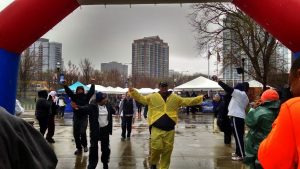Shanghai’s disconnect immediately juts out in the form of a disjointed cityscape. The sculpture, created by overlapping photographs done by artist Isidro Blasco, mimics contemporary China overtaking a series of red-roofed homes clustered in the center.
Blasco’s piece reflects constant construction and constant growth, from traditional Shanghai to a modernized Shanghai, causing fragmentation of the city. Visibly holding the piece together are wooden planks along with bright orange clamps. He shows Shanghai is not trying to disguise its development.
This piece and the ideas it represents are part of an exhibit at the Museum of Contemporary Photography entitled “Reversed Images: Representations of Shanghai and Its Contemporary Material Culture.” The exhibit features international artists representing the modernization of Shanghai as a city as well as its people through photography, video and sculpture.
Another prominent piece in the gallery by artist Shi Guorui shows the traditional, original cityscape and buildings of Shanghai juxtaposed with the modern, almost futuristic buildings being built across a river from one another. This piece was created using a camera obscura technique which entails shining a light through a small hole and allowing it to reflect an entire image into a room. This technique serves well to the exhibit’s title, according to Allison Grant, the education outreach coordinator at the museum, who calls it “a literal reversed image.”
“It really reflects what’s going on in the split of culture,” said Grant. “It is a literal reversed image, there is a literal split.”
The varying viewpoints of Shanghai’s young and old are shown through the work of father and son, Xu Xixian and Xu Jianrong, who photographed the same locations in Shanghai just two decades apart. A modern photograph showing the traffic filled streets of Shanghai is layered above a photograph of the same location as a sidewalk, with another modern photograph depicting the completed Shanghai skyline layered above a shorter skyline with unfinished building, though even the modern photographs possess an aged quality to them.
The difference between the photographs show not only how far Shanghai has come to modernization based on its own history, but how much farther they must go to reach Western standards of modern.
“That [piece] points out the lag time China’s having right now,” Grant said.
While the exhibit contains primarily photographs, artists such as Zhang Qing and the artistic collaborative group Speedism incorporated video and animation.
Zhang’s piece concentrated on the youth of Shanghai adapting to the close quarters left by traditional Shanghai architecture. The video depicts a group of young men attempting to play a game of soccer in their small three-room apartment, cramped in the space to the point where the game must not only be played on top of pieces of furniture, but practically on top of one another.
On the other hand, Speedism uses digital animation to represent the ideas of China’s past culture into an exaggeration of the newly formed China the young people are envisioning for themselves. As Grant puts it, they are incorporating “symbols of culture to create a false narrative of what it means to be a young person in China today.”
A series of pictures by Yang Fudong incorporates this same idea of false narrative for China’s youth. His photographs depict a young woman living, to Chinese standards, quite lavishly. It appears as if her image was stolen from a classic movie or television star, and the series plays out as a movie or television narrative. The woman is presented finely made up with a cigarette in hand and the costuming of a typical western starlet. This is a concept also familiar in the Western world, proving a movement of Western modernization in Shanghai youth.
These pieces show, according to Grant, a “performance of identity,” the Chinese youth enacting what they believe their identities should be as young people and not accepting the identity laid out by China’s past, as identities of Shanghai shift and the gap widens between the values of the young and old.
The Museum of Contemporary Photography is located at 600 S. Michigan Ave. and is open Monday through Saturday from 10 a.m. to 5 p.m., Thursday until 8 p.m., and Sundays noon to 5 p.m. The exhibit continues through Dec. 23. Admission is free.

![Reblog this post [with Zemanta]](http://img.zemanta.com/reblog_c.png?x-id=e058d479-a8b4-4577-a2b7-dd44182a6419)




Be First to Comment